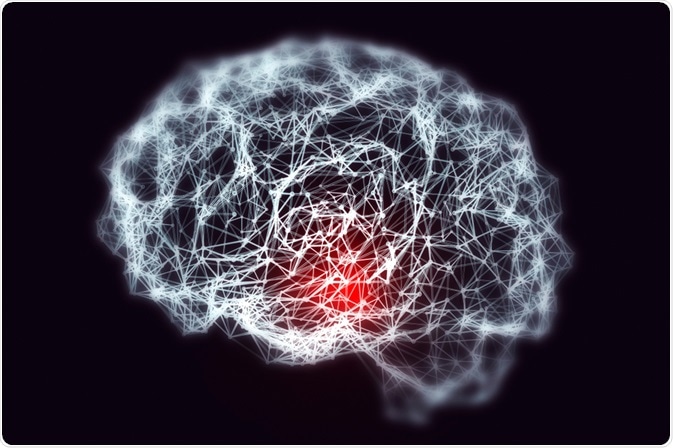A team of scientists at Johns Hopkins Medicine published a paper last month in the academic journal Neuron, describing how they used a laser-assisted imaging tool to demonstrate that motor-based learning occurs in multiple areas of the brain, rather than solely in the motor region, as previously thought.
 Image Credits: Kateryna Kon / Shutterstock.com
Image Credits: Kateryna Kon / Shutterstock.com
The team devised an experiment where they studied the brains of rats learning to reach out and take a food pellet in order to provide evidence for their theory of motor-based learning that they believe can be expanded to other types of learning as well.
New evidence suggests multiple brain areas are key for learning
There is growing support in the field of neuroscience for the suggestion that while there are specific brain areas specially adapted to perform specific tasks, scientists should still be considering the brain as a whole to fully understand brain functions.
There is mounting evidence that implicates the involvement of multiple brain areas in functions that were previously assumed to arise from a specific, localized region. Scientists at Johns Hopkins are on board with this new perspective, and they hypothesized that we should be looking at the entire brain in order to understand specific kinds of learning and that different brain regions likely contribute to learning in distinct ways.
Brain cell receptors were decided on as an appropriate area of focus to help uncover how these disparate areas connect with each other to enable learning to take place. The long-term goal of their work focusses on deepening our understanding of how learning occurs in order to help develop treatments for neurocognitive disorders where learning processes are abnormal.
Investigating the activity of AMPARs to signify learning
The team decided to focus on investigating AMPA-type glutamate receptors, known as AMPARs. These receptors are vital for facilitating communication between neurons in the brain. The AMPARs are located at the neuron’s synapses, where signals are transferred from one neuron to the next.
Previously, in order to analyze AMPARs levels in the brain, researchers had to acquire dissections of brain tissue prior to and following a learning task. Nowadays, scientists can use fluorescent tags to view and monitor the brain’s behavior in real-time during a learning task, measuring multiple synapses simultaneously.
The scientists injected the brains of mice with DNA-encoding AMPARs carrying fluorescent tags. Electrical pulses sent through the active neurons caused them to absorb the AMPAR DNA. Following this, the team used a technique called two-photon microscopy, which involves the use of a laser to read the levels of fluorescence emitted by the tagged AMPARs. The amount of fluorescence detected directly correlates with neuronal activity and indicates whether learning or memory building is occurring in those neurons.
To carry out the behavioral test that accompanied the imaging experiment in this study, rats were trained to reach and grab a food pellet placed outside their cage. Scientists were confident that acquiring these skills required learning as rats usually grab food with their mouths, not their paws.
The visual cortex is used for learning in the dark
The team observed a 20% increase in AMPAR activity occurring in the motor cortex while rats learned their task. This is unsurprising as the motor cortex has long been associated with coordinating movement, hence its name. The team also observed that AMPAR activity increased by the same amount in the visual cortex. Again, this is unsurprising as vision is very important for motor control.
Next, the team conducted the same experiment once again, but in the darkness this time, watching the animals using infrared light. The resultant imaging data showed that even in the dark, the brain enlists neurons in the visual cortex, however, this time there was just a 10% increase in AMPAR activity.
For the final part of the experiment, the team used specialized light-activated modulators that switched off neurons in either the motor or visual cortex and repeated the learning task. They found that the rats that had learned the task with the lights on were no longer able to perform the task with their visual cortex shut down. These findings imply that the visual cortex was being relied on for learning to take place, and was not just a side effect of needing vision to guide movement.
Potential future therapies
This study demonstrated that the motor cortex is not the only brain region essential for motor skill learning and that the nature of learning is not as specific as it has been assumed. The results add to the growing body of evidence that supports the idea that learning requires multiple brain regions, not just isolated, specialized areas.
The team finally notes that the SYNGAP gene is known to control the neuronal receptors that are involved in learning. In addition, there is evidence that mutations in this gene are linked with autism, intellectual disability, and schizophrenia, all of which are marked by disruptions or abnormalities in thinking and learning.
These findings have important implications for the development of treatments for these disorders, but more studies are needed to uncover the mechanisms behind the process of learning in the neurons and across brain regions.
Sources:
Bredt, D. and Nicoll, R. (2003). AMPA Receptor Trafficking at Excitatory Synapses. Neuron, 40(2), pp.361-379. https://www.cell.com/neuron/fulltext/S0896-6273(03)00640-8
Paulsen, J., Heaton, R., Sadek, J., Perry, W., Delis, D., Braff, D., Kuck, J., Zisook, S. and Jeste, D. (1995). The nature of learning and memory impairments in schizophrenia. Journal of the International Neuropsychological Society, 1(1), pp.88-99. www.cambridge.org/.../A568F5AF5FC0EC4DCF57FA440923D072
Roth, R., Cudmore, R., Tan, H., Hong, I., Zhang, Y. and Huganir, R. (2019). Cortical Synaptic AMPA Receptor Plasticity during Motor Learning. Neuron. www.cell.com/.../S0896-6273(19)31047-5
Further Reading